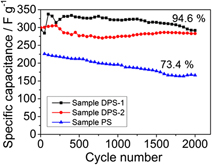Crossref Citations
This article has been cited by the following publications. This list is generated based on data provided by
Crossref.
Wang, Kui
Wang, Jixiao
Wu, Ying
Zhao, Song
Wang, Zhi
and
Wang, Shichang
2016.
Millisecond photo-thermal process on significant improvement of supercapacitor’s performance.
Applied Thermal Engineering,
Vol. 109,
Issue. ,
p.
186.
Eftekhari, Ali
Li, Lei
and
Yang, Yang
2017.
Polyaniline supercapacitors.
Journal of Power Sources,
Vol. 347,
Issue. ,
p.
86.
Guo, Wenxian
Chen, Meiqiong
Zhang, Yan
Yang, Wenna
Guo, Qiyao
Zhang, Min
and
Cheng, Faliang
2018.
Generation three-dimensional nitrogen-doped graphene frameworks as advanced electrode for supercapacitors.
Journal of Materials Research,
Vol. 33,
Issue. 9,
p.
1131.
Tan, Jilin
Xie, Zhuo
Zhang, Zhong
Sun, Yanan
Shi, Wei
and
Ge, Dongtao
2018.
Dopamine modified polyaniline with improved adhesion, dispersibility, and biocompatibility.
Journal of Materials Science,
Vol. 53,
Issue. 1,
p.
447.
Ghasemi, Seyedeh Sima
Hadavifar, Mojtaba
Maleki, Behrooz
and
Mohammadnia, Esmail
2019.
Adsorption of mercury ions from synthetic aqueous solution using polydopamine decorated SWCNTs.
Journal of Water Process Engineering,
Vol. 32,
Issue. ,
p.
100965.
Tian, Jinjun
Xue, Yan
Wang, Mengmeng
Pei, Yuanchao
Zhang, Hucheng
and
Wang, Jianji
2019.
Dopamine constructing composite of Ni(HCO3)2-polydopamine-reduced graphene oxide for high performance electrode in hybrid supercapacitors.
Electrochimica Acta,
Vol. 296,
Issue. ,
p.
49.
Hartmann, Sean J.
Iurchenkova, Anna A.
Kallio, Tanja
and
Fedorovskaya, Ekaterina O.
2020.
Electrochemical Properties of Nitrogen and Oxygen Doped Reduced Graphene Oxide.
Energies,
Vol. 13,
Issue. 2,
p.
312.
Yang, Muxuan
Liu, Yanghe
Luo, Xiongyu
Cao, Yan
Gong, Xiong
and
Xu, Weinan
2021.
Molecular Engineering of Polyaniline with Ultrathin Polydopamine and Monolayer Graphene for All-Solid-State Flexible Microsupercapacitors.
ACS Applied Energy Materials,
Vol. 4,
Issue. 9,
p.
10069.
Zhao, Xueyan
and
Pionteck, Jürgen
2021.
Electrochemical performance of polydopamine modified PANI/rGO composites: Dependency on preparation sequence.
Journal of Applied Polymer Science,
Vol. 138,
Issue. 28,
Mahanta, Vivekananda
and
Ramanujam, Kothandaraman
2022.
Vanadium—Polydopamine Flow Battery.
Journal of The Electrochemical Society,
Vol. 169,
Issue. 3,
p.
030525.
Tiwari, Pranjala
and
Janas, Dawid
2022.
Emergent pseudocapacitive behavior of single-walled carbon nanotube hybrids: a materials perspective.
Materials Chemistry Frontiers,
Vol. 6,
Issue. 17,
p.
2386.
Liu, Jie
Wang, Zhuang
liu, Qian
Li, Shuirong
Wang, Dechao
and
Zheng, Zhifeng
2022.
Rational design of freestanding and high-performance thick electrode from carbon foam modified with polypyrrole/polydopamine for supercapacitors.
Chemical Engineering Journal,
Vol. 447,
Issue. ,
p.
137562.
Dong, Wujie
Xie, Miao
Zhao, Siwei
Qin, Qiuliang
and
Huang, Fuqiang
2023.
Materials design and preparation for high energy density and high power density electrochemical supercapacitors.
Materials Science and Engineering: R: Reports,
Vol. 152,
Issue. ,
p.
100713.
Elanthamilan, Elaiyappillai
Ganeshkumar, Arumugam
Wang, Sea-Fue
Rajaram, Rajendran
Thriambakeshwar, Selvakumar
and
Velusamy, Mathiyazhagan
2023.
Fabrication of polydopamine/polyaniline decorated multiwalled carbon nanotube composite as multifunctional electrode material for supercapacitor applications.
Synthetic Metals,
Vol. 298,
Issue. ,
p.
117423.
Ishii, Chika
Asatani, Kimitaka
Sakata, Ichiro
and
Khalil, Khalil Abdelrazek
2024.
Detecting possible pairs of materials for composites using a material word co-occurrence network.
PLOS ONE,
Vol. 19,
Issue. 1,
p.
e0297361.



